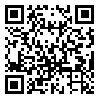1. Sotudeh H. Social pathology (sociology of deviations).7th ed. Tehran: Avayeh Nour Publication; 2001. P: 191-192
2. Tafreshi H. Addiction statistics in Iran. Razi. 2011;23(2):144-151.
3. Ministry of Health. There are 2,200,000 permanent addicts with daily intake in the country. Available at: URL: http://www.asriran.com/fa/news/233286. Accessed September 24, 2012.
4. Iran Drug Control Headquarters. The creation of 7 drug addiction camps. Available at: URL: http://yon.ir/JmZy7. Accessed June25, 2013.
5. Georgian B. Drug and delinquency. Journal of Medical, Legal, Criminology and Neurology. 2001;6(19):75-82.
6. Çırakoğlu OC, Işın G. Perception of drug addiction among Turkish university students: Causes, cures, and attitudes. Addictive Behaviors. 2005;30(1):1-8. [
DOI:10.1016/j.addbeh.2004.04.003] [
PMID]
7. Wright S, Klee H. Violent crime, aggression and amphetamine: What are the implications for drug treatment services?. Drugs: Education, Prevention and Policy. 2001;8(1):73-90. [
DOI:10.1080/09687630124890]
8. Shahabpour Arbab M. Comparison of the frequency of psychiatric disorders in addicts and normal people. [Doctorate Thesis]. Iran. Zahedan University of Medical Sciences, Faculty of Medicine; 2005. [Persian]
9. Jahangiri P, Gholamzadeh Na. Reviewing the relationship between societal control and tendency toward drug abuse among the youth. Societal Security Studies. 2011;26:129-155.
10. The Islamic Republic News Agency (IRNA). Eight people fall victim to drug abuse every day. Available at: URL: http://www.irna.ir/fa/News/81372304. Accessed November 1, 2014.
11. Iranian Students' News Agency (ISNA). Iran's addicts are more than Afghanistan. Available at: URL: http://www.shahrekhabar.com/analysis/ 1399363140018219. Accessed May 6, 2014.
12. Iranian Students' News Agency (ISNA). 63 percent of addicts are married. Available at: URL: http://www.isna.ir/news/95071409196/. Accessed Oct 6, 2016.
13. Iranian Students' News Agency (ISNA).The actual statistics of addiction were announced in universities. Available at: URL:http://www.ghatreh.com/news/nn1804469. Accessed Feb 16, 2013.
14. Sarvela PD, McClendon EJ. Indicators of rural youth drug use. Journal of Youth and Adolescence. 1988;17(4):335-47. [
DOI:10.1007/BF01537674] [
PMID]
15. Taylor RB. Crime and small-scale places: What we know, what we can prevent, and what else we need to know. At: Crime and place: Plenary Papers of the 1997 Conference on Criminal Justice Research and Evaluation; 1997 Jul; Washington, DC. National Institute of Justice; 1998: 3.
16. Felson M, Ronald WY. Opportunity and delinquency: Practical approach for the prevention of delinquency. 1th ed. Zanjan: Publishing of Danesh; 2009. P: 15.
17. Sherman LW, Gartin PR, Buerger ME. Hot spots of predatory crime: Routine activities and the criminology of place. Criminology. 1989;27(1):27-56. http://dx.doi.org/10.1111/j. 1745-9125.1989.tb00862.x [
DOI:10.1007/s11292-005-8133-z]
18. Braga AA. Hot spots policing and crime prevention: A systematic review of randomized controlled trials. Journal of Experimental Criminology. 2005;1(3):317-42. [
DOI:10.1007/s11292-005-8133-z]
19. Gonzales AR, Schofield RB, Hart SV,et al. Available at: URL: https://www.ncjrs.gov/ pdffiles1/nij/209393.pdf. Accessed Oct 25, 2017.
20. Majlesi M, Mardani H. Ambience detection and analysis of crime centers of bag theft, picking pockets, robbery in Zanjan township. Danesh e Entezami. 2012;4(57):91-115.
21. Kashaniju Kh. Recognizing of theoretical trends in relation to urban public spaces. Hoviatshahr. 2010;4(6):95-106.
22. Carmona M. Heath T, Oc T, Tiesdell S. Public places-urban spaces: The dimensions of urban design. 1th ed. Boston, MA: Architectural Press; 2003. P: 112.
23. Center for Statistics of Iran. Results of population and housing public census 2011. Available at: URL: https://nnt.sci.org.ir/sites/nnt/SitePages/report_90/ostani/ostani_population_report_final_permision.aspx. Accessed March 30, 2015.
24. Moazami T. Basic biostatistics. Available at: URL: http://stat.bpums.ac.ir/Fa/Article-643.htm. November 1, 2014.
25. Levy PS, Lemeshow S. Sampling of populations: Methods and applications. 1th ed. Tehran: Statistics Institute; 2002. P: 300.
26. Hakim Zadeh H. Sampling, sampling conference. Available at: URL: http://www.raveshtahqiq.blogsky.com/1385/03/27/post-5. Accessed June 12, 2006.
27. Mehraein M. Research method and statistics. 1st ed. Tehran: Publication of Sociologists; 2010. P: 75.
28. Nazari MA. The role of advertising in Attitude change of students toward addiction of Region 16 in Tehran [MS Thesis]. Tehran: Faculty of psychology, University of Social Welfare and Rehabilitation Sciences; 2000.
29. Barouni Sh, Mehrdad R, Akbari E. A survey of ecstasy use among 15-25 year-olds in five areas of TEHRAN. Tehran University Medical Journal. 2008;65(11):49-54.
30. Ismail Pour N, Hazeri M, Dasta F. investigation of spatial distribution of police offices and its relationship with mass depression in Yazd. Journal of Geography and Environmental Studies. 2015;3(11):36-23.







